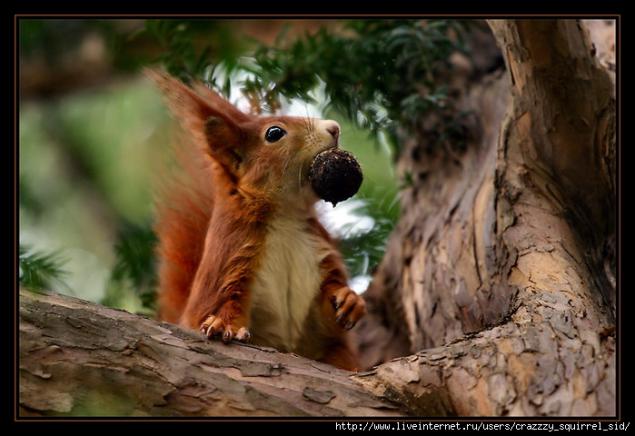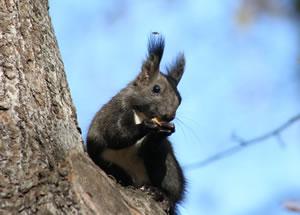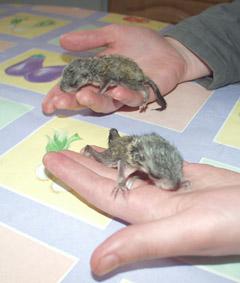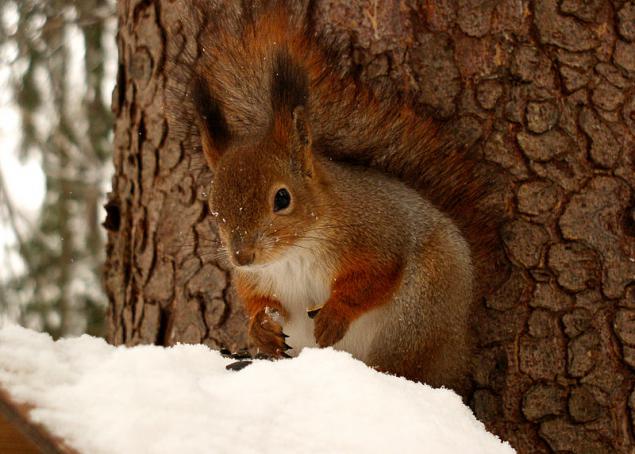Proteins
 Bashny.Net
Bashny.Net
To you came squirrel ?! Let's see, friend or foe.
1 Protein (lat. Sciurus) - genus of rodent squirrel family. Also a kind Sciurus, proteins, also called a number of members of the family of squirrel genera burundukovye proteins (Tamiasciurus), palm squirrels (Funambulus) and many others. As for the kind of sciurus, it combines an about 30 species, distributed in Europe, North and South America and in the temperate zone of Asia.
Has the extended body with a fluffy long tail, ears long, color dark brown with a white paunch, sometimes gray (especially in winter). They are found everywhere except Australia. Protein provides valuable fur.
It is very curious and frisky rodent has long called veveritsey or Vaxjo. The present name was transferred from the name of a bargaining chip, "white", which just served the skins of these animals. "Animals," or, as they are called, "selfish", money was put into the trade turnover has since ancient times. Although the size of the skins is small (very small animal weighs about 250 grams), the protein was in the fur price is always

2. One of the well-known distinctive features of many protein is their ability to store nuts for the winter. Some kinds of nuts buried in the ground, while others hide them in the hollows of trees. As scientists believe, poor memory of some protein species, in particular sulfur and helps to conserve forests since they are buried in the ground nuts and forget about them, from germinated seeds are new trees. Some types of protein in the case of alleged dangers stand on his hind legs, front buckle and then look around the surrounding area. Upon detection of the enemy often emit a shrill sound to warn other protein.
Despite the widespread opinion, squirrels are omnivorous: in addition to nuts seeds, fruits, mushrooms and green vegetation, they also eat insects, eggs, and even small birds, mammals and frogs.
Very often these foods replace nuts proteins in tropical countries.

3. Proteins are considered to be intelligent animals in the settlements they are able to feed from the bird feeders, digging in search of plants planted seeds and settle in areas such as the attic.
Sometimes proteins are considered pests because they can chew on everything that is possible and impossible; their teeth are always sharp and gradually worn down (rodent teeth grow continuously). Homeowners in areas with large populations of protein should carefully close their basements and attics, because proteins can arrange their nests there, or to spoil anything. Some residents use more humane methods to deter squirrels - throw in attics and basements wool pets (dogs or cats) that gives the proteins in these places to feel the presence of a predator. Stuffed animals are usually ignored by the animals, and the best way to prevent any thing from damage - is to lubricate it than anything inedible like black pepper. Sometimes the protein set traps and then transferred them away from home.
The protein can be tamed for feeding with it. Because they are adapted to hide surplus food, they will take you as much as you will be offering. If a person begins to lure the squirrel, it comes back to him the next day for more. Squirrels living in parks and gardens in the city, has long learned that a man is a source of food. Feed protein with it is still not recommended, as they can be infected with plague or other animal diseases. Even if they are not sick, they could injure your hand or painful bite.

4. These proteins - is 20-35 cm long little animals with fluffy tails. They live in coniferous and mixed forests of Eurasia and North America. Color fur protein depends not only on the species, but also on the habitat. For example, common proteins which can be found in Moscow parks, are not only red but also brown and almost black. In winter, the majority of ordinary protein changes a red coat on the gray, the color of which also varies from pale silver to the asphalt. It inhabits the North American gray squirrel year-round is olive-gray coat and black Manchu proteins like embers. And the North American, European, and Asian proteins belonging to the genus of this protein are similar lifestyle. A summer day forest busybody run through the woods, gathering nuts, berries, fruits and mushrooms. They try not only satisfied, but also to make reserves for the future, for the winter. Numerous kladovochku in tree hollows between the roots and leaf litter household little animals hiding nuts and bumps. Mushrooms and berries are dried, impaling them on the branches, and then also hidden in a nest or kladovochku. Proteins that live alone or, more rarely, couples, occupy a certain area of the forest, which collected food. His little animals guarding the territory are not very careful and abundant food while tolerant of guests.

5. territorial conflicts rarely go beyond threats. Oncoming the day on business at night to sleep proteins fit into the slot at the branches. Such a nest - Heine - made of twigs, is a sphere inside for warmth lined with bark, moss and soft grass. If there is a suitable hollow, the protein uses it for housing.

6. The Cubs have proteins appear twice a year for 3-4 squirrel in the litter. Squirrels are born naked, blind and completely helpless. Only 20 days to the baby covered with fur, and eyes have opened a month after birth. Clearwisdom Belchatow grow rapidly in 2 months already leaving the mother's nest to take a run through the woods in search of free territory.

7. The most difficult time for the protein - winter. These rodents, unlike many of his relatives living in the same latitudes, do not fall for the winter in hibernation. In winter they are fed summer inventory. Thanks to the excellent instincts find their kladovochku deep under snow. Intuition helps find protein and foreign supplies, and, of course, she does not deny myself the pleasure to destroy taynichok nutcrackers or chipmunk. Forgetful squirrel in the winter is not all of their supplies, and unfound treasure seeds germinate in the spring. Since proteins are helping the forest - the seeds buried in the ground, act as a gardener. The frost proteins do not leave their nests for several days - it's warm and the temperature rarely falls below 10 ° C. In the apartment there are food supply, as part of the preparations in the summer of protein reserves in the nest specially for such cases.

8. The proteins are called not only representatives of this kind of protein, but also representatives of other genera, similar to the protein. The largest - the giant squirrel, weighing; up to 3 kg and a length (without tail) to 47 cm. These elegant creatures with tassels on the ears are found in Southeast Asia. They are 4 types: a giant, cream-colored, two-colored and Indian.

9. Most small proteins - proteins mouse living in the tropical forests of Africa. Their size does not exceed 8 cm. In South-East Asia and the islands of the Malay Archipelago live fine proteins, fully justifies its name. Among them are absolutely white Finlayson protein and protein Prevost beautiful tricolor with a black back, white sides and a reddish belly. Funny Indian painted palm proteins: their backs are decorated with several light longitudinal stripes. Indian Palm Squirrel live in small flocks. They are quite tolerant of human presence. They can be found in city parks in India basking in the sun the whole small group, clung to a tree trunk. These squirrels - lovers of nectar, and even act as pollinators of some plants. Ground squirrels live in open spaces in Africa. They often live in small colonies and dig burrows.
All proteins prefer vegetarian food, but may well complement the menu insects, bird eggs, chicks and other small creatures.

Source: http: //
1 Protein (lat. Sciurus) - genus of rodent squirrel family. Also a kind Sciurus, proteins, also called a number of members of the family of squirrel genera burundukovye proteins (Tamiasciurus), palm squirrels (Funambulus) and many others. As for the kind of sciurus, it combines an about 30 species, distributed in Europe, North and South America and in the temperate zone of Asia.
Has the extended body with a fluffy long tail, ears long, color dark brown with a white paunch, sometimes gray (especially in winter). They are found everywhere except Australia. Protein provides valuable fur.
It is very curious and frisky rodent has long called veveritsey or Vaxjo. The present name was transferred from the name of a bargaining chip, "white", which just served the skins of these animals. "Animals," or, as they are called, "selfish", money was put into the trade turnover has since ancient times. Although the size of the skins is small (very small animal weighs about 250 grams), the protein was in the fur price is always

2. One of the well-known distinctive features of many protein is their ability to store nuts for the winter. Some kinds of nuts buried in the ground, while others hide them in the hollows of trees. As scientists believe, poor memory of some protein species, in particular sulfur and helps to conserve forests since they are buried in the ground nuts and forget about them, from germinated seeds are new trees. Some types of protein in the case of alleged dangers stand on his hind legs, front buckle and then look around the surrounding area. Upon detection of the enemy often emit a shrill sound to warn other protein.
Despite the widespread opinion, squirrels are omnivorous: in addition to nuts seeds, fruits, mushrooms and green vegetation, they also eat insects, eggs, and even small birds, mammals and frogs.
Very often these foods replace nuts proteins in tropical countries.

3. Proteins are considered to be intelligent animals in the settlements they are able to feed from the bird feeders, digging in search of plants planted seeds and settle in areas such as the attic.
Sometimes proteins are considered pests because they can chew on everything that is possible and impossible; their teeth are always sharp and gradually worn down (rodent teeth grow continuously). Homeowners in areas with large populations of protein should carefully close their basements and attics, because proteins can arrange their nests there, or to spoil anything. Some residents use more humane methods to deter squirrels - throw in attics and basements wool pets (dogs or cats) that gives the proteins in these places to feel the presence of a predator. Stuffed animals are usually ignored by the animals, and the best way to prevent any thing from damage - is to lubricate it than anything inedible like black pepper. Sometimes the protein set traps and then transferred them away from home.
The protein can be tamed for feeding with it. Because they are adapted to hide surplus food, they will take you as much as you will be offering. If a person begins to lure the squirrel, it comes back to him the next day for more. Squirrels living in parks and gardens in the city, has long learned that a man is a source of food. Feed protein with it is still not recommended, as they can be infected with plague or other animal diseases. Even if they are not sick, they could injure your hand or painful bite.

4. These proteins - is 20-35 cm long little animals with fluffy tails. They live in coniferous and mixed forests of Eurasia and North America. Color fur protein depends not only on the species, but also on the habitat. For example, common proteins which can be found in Moscow parks, are not only red but also brown and almost black. In winter, the majority of ordinary protein changes a red coat on the gray, the color of which also varies from pale silver to the asphalt. It inhabits the North American gray squirrel year-round is olive-gray coat and black Manchu proteins like embers. And the North American, European, and Asian proteins belonging to the genus of this protein are similar lifestyle. A summer day forest busybody run through the woods, gathering nuts, berries, fruits and mushrooms. They try not only satisfied, but also to make reserves for the future, for the winter. Numerous kladovochku in tree hollows between the roots and leaf litter household little animals hiding nuts and bumps. Mushrooms and berries are dried, impaling them on the branches, and then also hidden in a nest or kladovochku. Proteins that live alone or, more rarely, couples, occupy a certain area of the forest, which collected food. His little animals guarding the territory are not very careful and abundant food while tolerant of guests.

5. territorial conflicts rarely go beyond threats. Oncoming the day on business at night to sleep proteins fit into the slot at the branches. Such a nest - Heine - made of twigs, is a sphere inside for warmth lined with bark, moss and soft grass. If there is a suitable hollow, the protein uses it for housing.

6. The Cubs have proteins appear twice a year for 3-4 squirrel in the litter. Squirrels are born naked, blind and completely helpless. Only 20 days to the baby covered with fur, and eyes have opened a month after birth. Clearwisdom Belchatow grow rapidly in 2 months already leaving the mother's nest to take a run through the woods in search of free territory.

7. The most difficult time for the protein - winter. These rodents, unlike many of his relatives living in the same latitudes, do not fall for the winter in hibernation. In winter they are fed summer inventory. Thanks to the excellent instincts find their kladovochku deep under snow. Intuition helps find protein and foreign supplies, and, of course, she does not deny myself the pleasure to destroy taynichok nutcrackers or chipmunk. Forgetful squirrel in the winter is not all of their supplies, and unfound treasure seeds germinate in the spring. Since proteins are helping the forest - the seeds buried in the ground, act as a gardener. The frost proteins do not leave their nests for several days - it's warm and the temperature rarely falls below 10 ° C. In the apartment there are food supply, as part of the preparations in the summer of protein reserves in the nest specially for such cases.

8. The proteins are called not only representatives of this kind of protein, but also representatives of other genera, similar to the protein. The largest - the giant squirrel, weighing; up to 3 kg and a length (without tail) to 47 cm. These elegant creatures with tassels on the ears are found in Southeast Asia. They are 4 types: a giant, cream-colored, two-colored and Indian.

9. Most small proteins - proteins mouse living in the tropical forests of Africa. Their size does not exceed 8 cm. In South-East Asia and the islands of the Malay Archipelago live fine proteins, fully justifies its name. Among them are absolutely white Finlayson protein and protein Prevost beautiful tricolor with a black back, white sides and a reddish belly. Funny Indian painted palm proteins: their backs are decorated with several light longitudinal stripes. Indian Palm Squirrel live in small flocks. They are quite tolerant of human presence. They can be found in city parks in India basking in the sun the whole small group, clung to a tree trunk. These squirrels - lovers of nectar, and even act as pollinators of some plants. Ground squirrels live in open spaces in Africa. They often live in small colonies and dig burrows.
All proteins prefer vegetarian food, but may well complement the menu insects, bird eggs, chicks and other small creatures.

Source: http: //
Tags
See also
The victory in the Six Day War, 1967 (29 pics + text)
About deserved rating of Putin
If you have never donated blood, then you might be interested in ...
Interesting about cats
TESTED RECIPES healers.
Nechama Milson: 10 tips unborn child to his parents
Lazy Brain: The enemy within
The cultivation of mushrooms in the country

















